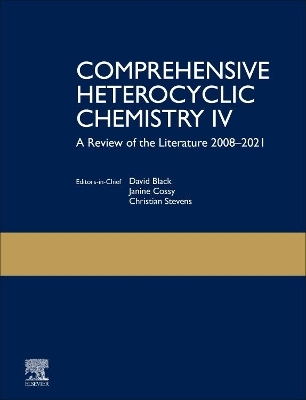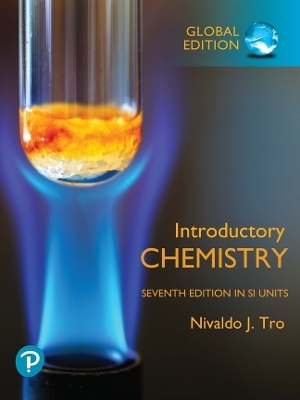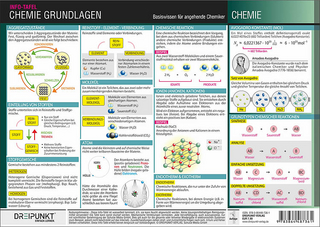
Comprehensive Heterocyclic Chemistry IV
Elsevier Science Publishing Co Inc
978-0-12-818655-8 (ISBN)
This comprehensive resource is designed to be used both as a standalone resource and in conjunction with earlier works.
Professor David Black, School of Chemistry, University of New South Wales, Australia. Professor David Black studied chemistry at the University of Sydney. Following a Masters degree mentored by Francis Lions, he was awarded an Overseas Scholarship of the Royal Commission for the Exhibition of 1851 to undertake a PhD in Cambridge with Lord Todd. After post-doctoral research with Thomas Katz at Columbia University, he was appointed to a lectureship at Monash University. In 1983 he moved to the chair of organic chemistry at the University of New South Wales. He has spent periods of study leave at the ETH Zürich (with Albert Eschenmoser), Würzburg University as an Alexander von Humboldt Fellow (with Siegfried Hünig) and Cambridge University (with Alan Battersby). He has also held Visiting Professorships in Tokyo, Auckland, Göttingen, Innsbruck and Kobe. He has won the Rennie, Smith, Birch and Leighton Medals of the Royal Australian Chemical Institute, of which he served as National President in 1998. David Black has also contributed to international science as Secretary General of the International Union of Pure and Applied Chemistry from 2004-2011, and Secretary General of the International Council for Science from 2011-2018. He is a Fellow of the Australian Academy of Science and an Officer of the Order of Australia. He was recently awarded the 2017 Craig Medal of the Australian Academy of Science. Professor Black has made major contributions to organic chemistry in the general fields of heterocyclic chemistry, coordination chemistry and natural products. His research has focused on the design and synthesis of new molecular structural types, often related to important known natural products, but displaying deliberate reactivity variations that are not found in nature. He was a pioneer in the use of metal coordination for the control of organic reactions, and has also discovered new reactions of activated indoles leading to the construction of molecular receptors and small peptide mimics. Janine Cossy Molecular, Macromolecular Chemistry and Materials (C3M) ESPCI Paris, PSL University, CNRS, 75005 Paris, France Professor Janine Cossy graduated from the University of Reims (France) working under the supervision of Prof. Jean-Pierre Pète. After a postdoctoral stay with Prof. Barry Trost (1980-1982) at the University of Wisconsin (USA), she returned to Reims where she became Director of Research CNRS in 1990. The same year, she moved to Paris to become Professor of Organic Chemistry at the Ecole Supérieure de Physique et de Chimie Industrielles de la Ville de Paris (ESPCI Paris). She has published more than 560 articles and filed 18 patents in the field of synthetic organic chemistry and natural product synthesis. She was Associate Editor at Organic Letters from 2005 to 2018 and since October 2023, she is Tetrahedron Associate Editor. Her research efforts have resulted in more than 560 publications and 18 patents. Among the awards, she received: the CNRS Silver Medal (France, 1996); the UK Royal Society Rosalyn Franklin International Lecturership awarded to internationally recognized women scientists (UK, 2005); the E. C. Taylor Senior Award (2015); the IUPAC 2019 Distinguished Women in Chemistry or Chemical Engineering (2019). She was elected at the French Academy of sciences in 2017 and in 2022, she has been elected at the national Academy of Pharmacy. In addition, she was nominated Chevalier de l’Ordre National du Mérite and promoted to Officier in 2018. In 2013, she was nominated Chevalier de la Légion d’Honneur and was promoted to Officier in 2023. She is the co-funder of two companies: CDP-Innovation and Acanthe Biotech. Affiliations Molecular, Macromolecular Chemistry and Materials (C3M) ESPCI Paris, PSL University, CNRS, 75005 Paris, France Expertise Development of synthetic methods: Enantioselective reactions, rearrangements, radicals, photochemistry, organometallic reactions, biocatalysis, plasma reactions. Synthesis of natural products and/or bioactive compounds. Prof. Dr. Christian Stevens, Faculty of Bioscience Engineering, University of Ghent, Belgium. Prof. Dr. Ir. Christian V. Stevens is professor at the Department of Sustainable Organic Chemistry and Technology at the Faculty of Bioscience Engineering (Ghent University). He graduated at the same department as bio-engineer in chemistry in 1988 and obtainded a PhD in 1992 as fellow of the National Fund for Scientific Research. During his PhD he also worked as a research assistant of the University of Southern California (USC), Los Angeles, USA with Prof. C.E. McKenna. After his PhD at Ghent University under the direction of Prof. N. De Kimpe, he did post-doctoral work at the Center for Heterocyclic Compounds at the University of Florida, USA under the direction of Prof. A. R. Katritzky as a NATO Research Fellow. He became group leader in the group of Prof. Katritzky in 1993. He returned as a postdoctoral fellow of the National Fund for Scientific Research. In 1994, he also made a short postdoctoral stay at the University of Alicante (Spain) under the direction of Prof. M. Yus. In 1995, he became group leader of the National Fund for Scientific Research and became guest professor in 1997 at Ghent University. In 2000, he became professor at the current Faculty of Bioscience Engineering and developed the research group SynBioC of which he is the director. He became full professor in 2014. Member of the Editorial Board: Green Chemistry; Advances in Heterocyclic Chemistry; Arkivoc; Biofuels, Bioproducts and Biorefining (Biofpr, Wiley); Current Opinion in Green and Sustainable Chemistry. Member of the International Advisory Board: European Journal of Organic Chemistry; Journal of Flow Chemistry. Series Editor: Wiley series on Renewable Resources.
1. Three-membered Heterocycles, and all Fused Systems with a Three-membered Heterocyclic Ring Matthias D'hooghe 2. Four-membered Heterocycles, and all Fused Systems with a Four-membered Heterocyclic Ring Gwilherm Evano 3. Five-membered Rings with One Heteroatom together with their Benzo and other Carbocyclic-fused Derivatives Henry Wong 4. Five-membered rings with two heteroatoms and fused carbocyclic derivatives Alan Aitken 5. Five-membered Rings: Triazoles, Oxadiazoles, Thiadiazoles and their Fused Carbocyclic Derivatives Panayiotis Koutentis 6. Other Five-membered Rings with Three or more Heteroatoms, and their Fused Carbocyclic Derivatives Jason Smith 7. Six-membered Rings with One Heteroatom, and their Fused Carbocyclic Derivatives Nuno Maulide 8. Six-membered Rings with Two Heteroatoms, and their Fused Carbocyclic Derivatives Steven Weinreb 9. Six-membered Rings with Three or more Heteroatoms, and their Fused Carbocyclic Derivatives Santosh Gharpure 10. Ring Systems with at least Two Fused Heterocyclic Five- or Six-membered Rings with no Bridgehead Heteroatom Fawaz Aldabbagh 11. Bicyclic 5-5 and 5-6 Fused Ring Systems with at least One Bridgehead (Ring Junction) Geraldine Masson 12. Five- and Six-membered Fused Systems with Bridgehead (Ring Junction) Heteroatoms Including 6-6 Bicyclic with One or Two N or Other Heteroatoms, Polycyclic, Spirocyclic Lucjan Strekowski 13. Seven-membered Heterocyclic Rings and their Fused Derivatives Floris Rutjes 14. Eight-membered and larger Heterocyclic Rings and their Fused Derivatives; Other Seven-membered Rings Ari Koskinen
| Erscheint lt. Verlag | 2.12.2021 |
|---|---|
| Mitarbeit |
Chef-Herausgeber: David Black, Janine Cossy, Christian Stevens |
| Sprache | englisch |
| Maße | 216 x 276 mm |
| Themenwelt | Naturwissenschaften ► Chemie |
| ISBN-10 | 0-12-818655-0 / 0128186550 |
| ISBN-13 | 978-0-12-818655-8 / 9780128186558 |
| Zustand | Neuware |
| Haben Sie eine Frage zum Produkt? |
aus dem Bereich


